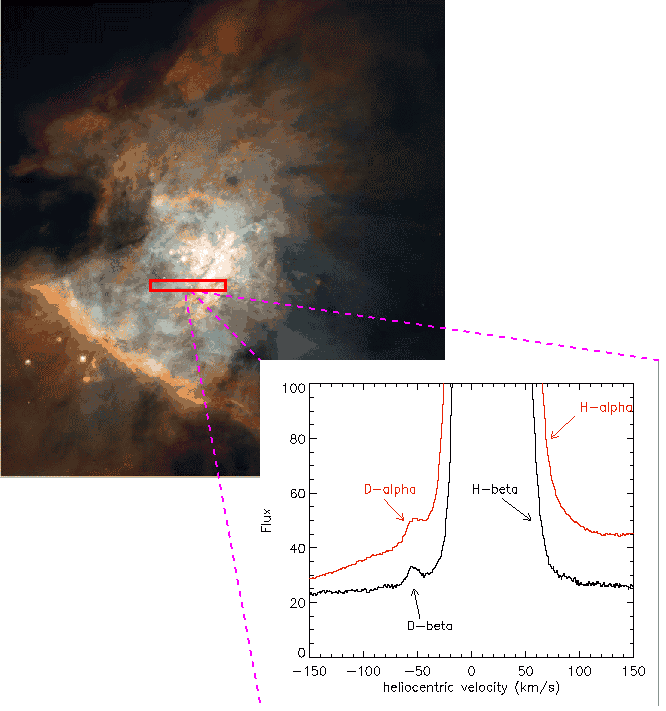
Deuterium in Orion
Credit: Image courtesy of G. Hébrard
Institut d'Astrophysique, Paris, France
(for more details see: Hébrard, Péquignot, Vidal-Madjar, Walsh, Ferlet, 2000, Astronomy & Astrophysics Letters, Vol. 354, p. L79-L82.)

Hydrogen is the most abundant element in the Universe, by far! It is
the lightest and simplest element, with only one light negatively
charged particle, an electron, orbiting one heavy positively charged
particle, a proton. Sometimes an extra neutron is tied to the proton,
in that case there are two particles in the nucleus and Hydrogen is
then called Deuterium. It is rare relative to normal Hydrogen.
Current scenarios for the synthesis of atomic elements, the
nucleosynthesis, suggest that Deuterium was entirely created during
the Big Bang and that it's abundance has been steadily decreasing
since then. Deuterium is destroyed by astration - the
production by stars of heavier atomic elements (Helium, Carbon,
Nitrogen, Oxygen, etc...) from lighter ones (Hydrogen or Deuterium)
Various measurements of the Deuterium abundance exist. Intergalactic
clouds are old and contain the signature of Deuterium as it was 15
billion years ago, very early in the history of the universe. Giant
planets (Jupiter, Saturn) in our solar system trace
Deuterium as it was at the epoch of formation of our planetary system,
4.5 billion years ago. The nearby interstellar medium contains traces
of deuterium as it remains today. These measurements show that the
abundance of Deuterium decreased by a factor 2 or 3 over 15 billion
years. However, although the general trends in its evolution are
understood, there is considerable variations in the measurements and
any new and reliable way of estimating Deuterium abundance is welcome.
This week's image, or spectra rather!, is the result of a recent and
innovative attempt to measure Deuterium in the nearby interstellar
medium. The group of astronomers pointed the Canada-France-Hawaii
Telescope to the great Nebula in Orion, just South of the
Trapezium. Because it contains many bright stars, the surrounding gas
is ionised and the emission lines of Hydrogen in particular are very
intense. Two lines of the Hydrogen Balmer series are partly visible in
this week's spectra. They are H-alpha and H-beta (labeled in the
image). They correspond to transition from the N = 3->2 and N=4->2
electronic levels. The lines are so bright that they do not fit on the
image, they had to be truncated. On the scale showed on the left of
the image, H-alpha has an intensity of 7250 and H-beta 2500! What is
interesting are the two smaller lines identified to the left of the
normal Hydrogen ones. The team identifed these lines as the
corresponding lines of Deuterium. Hence their names: D-alpha and
D-beta.
This is the first time Deuterium is identified in a Nebula by optical
spectroscopy and further research will allow to derive an estimation
of its abundance.
The spectra presented this week were obtained with Gecko,
CFHT's coudé echelle spectrograph. The high surface brightness
of the Orion nebula helped to secure these high quality, high
signal-to-noise observations. Integration times were 4.5 hours for the
H-alpha/D-alpha spectrum and 1.5 hours for H-beta/D-beta spectrum.
Deuterium was detected at three different position in the Orion
Nebula. The position of one of the spectrograph entrance slit, south
of the Trapezium is presented for orientation. It is not to scale. The
actual slit was 40" long and about 3" wide, slightly different for
H-alpha and H-beta.
Technical description:



